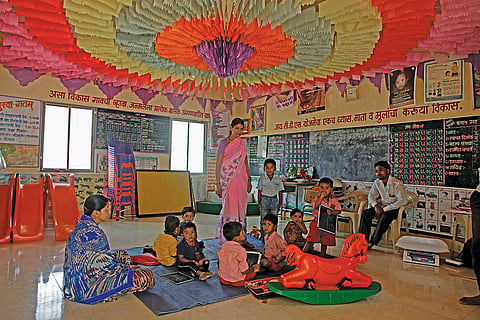

In 2022, we took a pledge to remove poverty from our village by 2030 and ensure employment of all residents. With our efforts, women in the village now work with self-help groups, while men earn through self-employment schemes,” says Vinayak Gaikwad, sarpanch of Khandobachi Wadi, a village in Maharashtra Sangli district. In 2023, the National Panchayat Per-formance Assessment Committee awarded the village the first prize under “Poverty free and enhanced livelihoods” category. The award allows the panchayat to undertake works worth up to R1 crore in the village.
These were India’s first National Panchayat Awards and will be an annual feature. The official dashboard of the panchayat awards says that its primary aim is “to assess the performance” of panchayats in meeting the UN’s 17 Sustainable Development Goals (SDGs) for 2030.
India has been chasing SDGs since the UN adopted them in 2015. To this end, the Niti Aayog releases an SDG Index Report every year since 2018. But in 2019, the country’s apex public policy think tank asked the government to focus on Localisation of Sustainable Goals (LSDG). The task went to the Union Ministry of Panchayati Raj. In May 2021, the ministry set up a high-power committee, which submitted a report in October 2021. The report forms the basis of the awards.
Acting on the report, the ministry divided the 17 UN SDGs into nine themes, while also incorporating the 29 panchayat subjects under the XIth Schedule of Constitution of India (see ‘Thematic integration’). The ministry then asked villages to prepare their Gram Vikas Panchayat Plan (GPDP) on the basis of nine themes. The top three panchayats are awarded in each category.
The plan culminated on April 24, 2022, on the occasion of National Panchayati Raj Day, when all the gram panchayats pledged to implement LSDGS. “Except the award, panchayats are not being given any incentive to meet LSDGs,” says Chandra Shekhar Kumar, additional secretary, Union Ministry of Panchayati Raj. “The government is also not spending any extra money on the awards. The cash component is being drawn from the funds allocated to panchayats,” Kumar tells Down To Earth (DTE).
“The panchayats have potential to make a significant contribution to SDGs, particularly those related to poverty alleviation, clean water supply, sanitation and education,” says Saroj Mahapatra, executive director of Delhi-based non-profit Professional Assistance for Development Action. “But the big question is if the integration of SDGS with panchayat’s will bear results,” he says.
If India is to achieve SDGS, its big states will have to pick pace in this direction. The biggest state in terms of population and panchayat numbers is Uttar Pradesh. It has 58,187 or 23 per cent of India’s total panchayats (255,228). To assess the progress made in aligning SDGs with panchayats’ goals in the state, DTE visited the Block Development Office (BDO) of Loni town in Uttar Pradesh’s Ghaziabad district on September 28.
“Work is being done on the LSDG themes in all the 22 panchayats of this block,” said assistant block development officer Vipin Kumar. But he could not provide basic information, such as the themes that the panchayats have pledged to focus on. “This information is saved in the computer, but the operator resigned a month ago. It cannot be accessed till another operator is here,” he said. Kumar also expressed inability to accompany this reporter to any village where work is being done to achieve as per LSDGS.
A chance meeting with Suresh Bainsla at the BDO office, whose wife is pradhan of Mewla Bhatti village in Ghaziabad, helped as he offered to show around his village. “Our village has won a panchayat award in the ‘Child Friendly’ category,” Bainsla said.
On visit, the village looked quite good, with all the facilities in place. “All the children go to school. Some 40 children are also registered at Aanganwadi for regular health checkups,” pradhan Kusum Bainsla said. “The two ponds have been beautified and soak pits made near the hand pumps ensure that the wastewater seeps underground. This has won us an award in ‘Water Sufficient’ category,” she added.
A look at the certificates showed that these were awarded by the state government for 2021-22. She did not know the categories the village had pledged for LSDGs. “Our panchayat secretary will have that data, but he is not here,” she said.
“Though the initiative is important, synchronising the works of different panchayat schemes with SDGs will be quite challenging. There is little coordination between the government departments working in a village, neither do the departments want any convergence,” says Anjan Kumar Bhanja, associate professor and head, Centre for Panchayati Raj, Decentralised Planning and Social Service Delivery; National Institute of Rural Development and Panchayati Raj. Mahapatra suggests that GPDPs should be made for three or five years, rather than every year, to ensure enough time for convergence of goals.
Loni’s case also shows that panchayats often lack the administrative, financial and technical capacity to effectively implement large-scale development projects.
With just over five years left to meet SDGS, experts say that the government’s move to bring in panchayats could be a way to escape responsibility. “The government declared villages open defecation-free on the basis of panchayats’ claims. What if it does the same in the case of SDGs,” asks Mahapatra. “In tribal villages there are cases when even the sarpanch does not know how to read or write and depends on panchayat officials. They do not know of these LSDGS. What if they are made to declare completion of targets? It will remain only on paper,” says Ganga Ram Pekra, a tribal activist from Surguja district of Chhattisgarh.
This was first published in the 16-31 October, 2024 print edition of Down To Earth